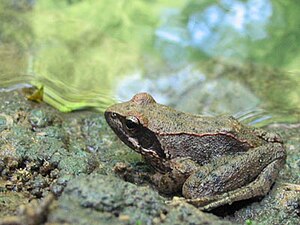Italian frog
| Italian frog | ||||||||||||
|---|---|---|---|---|---|---|---|---|---|---|---|---|

Italian frog ( Rana italica ) |
||||||||||||
| Systematics | ||||||||||||
|
||||||||||||
| Scientific name | ||||||||||||
| Rana italica | ||||||||||||
| Dubois , 1985 |
The Italian frog ( Rana italica ) is within the order of Anura to the family of Real frogs and also for species of genuine frogs . In addition, it is counted according to appearance, way of life and relationships to the complex of forms of the brown frogs . It can only be found in the hills and mountains of Italy .
features
The Italian frog is about 40 to 60 mm long. It is a small and relatively clumsy brown frog with a short snout and long legs. It is very similar to the Greek frog ( Rana graeca ), as the subspecies of which it was originally considered. The back color is variable brownish, reddish or yellowish with light, fuzzy spots. The ventral side is whitish in color, the throat dark with light spots and a longitudinal stripe in the middle. The skin, apart from the dorsolateral glandular ridges, is quite smooth. The males have internal vocal sacs .
When the hind leg is laid forward, the heel joint extends beyond the tip of the snout, which distinguishes the frog from some other species.
distribution and habitat
The distribution area of the Italian frog is limited to the largest part of the Italian boot southeast of Genoa , with the frog mainly found in the hills and mountains ( Apennines ) up to 1700 m altitude. As a habitat, it prefers cool and oxygen-rich mountain streams and springs and is strongly bound to the water. The bottom of the water is stony and poor in vegetation.
Way of life
The breeding season of the Italian frog is from February to April. The female lays 200 to 1000 eggs under stones near the bank (compare also Greek frog ).
Danger
The Italian frog is classified as Least Concern in the IUCN Red List of Threatened Species because it has a relatively large range, greater adaptability to habitat changes and a relatively large overall population. The main threat to this species comes from habitat loss, which occurs as a result of increasing habitat change through agriculture and settlement.
Legal protection status
- Fauna-Flora-Habitat Directive (FFH-RL): Annex IV (strictly protected)
- Federal Species Protection Ordinance (BArtSchV): particularly protected
Evidence cited
- ↑ a b Rana italica in the endangered Red List species the IUCN 2007. Posted by: Andreone, F., 2004. Accessed July 26 of 2008.
literature
- Axel Kwet: Reptiles and Amphibians of Europe . Franckh'sche Verlagsbuchhandlung, Stuttgart 2005, p. 99, ISBN 3-440-10237-8
Web links
- Photos by Rana italica at herp.it
- Global Amphibian Assessment: Rana italica (English; including distribution map)